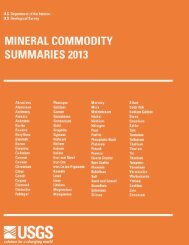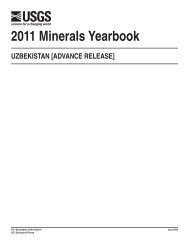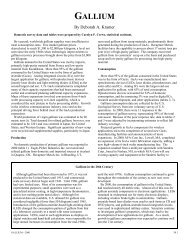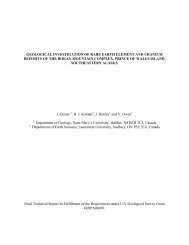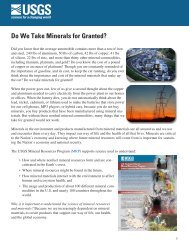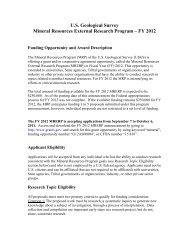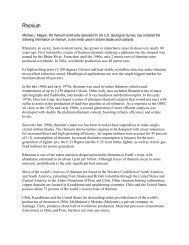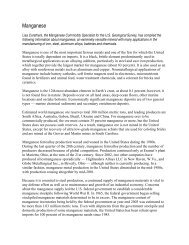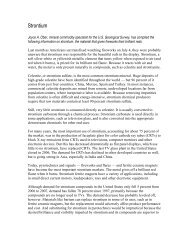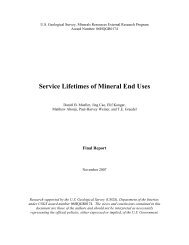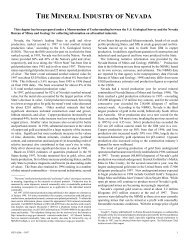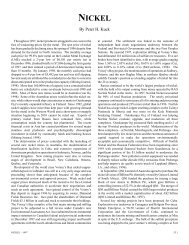Mineral Commodity Summaries 2003 - Mineral Resources Program ...
Mineral Commodity Summaries 2003 - Mineral Resources Program ...
Mineral Commodity Summaries 2003 - Mineral Resources Program ...
You also want an ePaper? Increase the reach of your titles
YUMPU automatically turns print PDFs into web optimized ePapers that Google loves.
LEAD<br />
Events, Trends, and Issues: During 2002, the price for refined lead decreased in the United States and world<br />
markets. The average North American Producer and London Metal Exchange prices for the first 9 months of the year<br />
were 0.1% and 3.7%, respectively, below the averages for the previous year. Worldwide demand for lead remained<br />
essentially unchanged in 2002, as the decline in demand for batteries, particularly in the United States, was countered<br />
by rising demand for batteries and other lead products in Asia, driven mainly by further industrial growth in China.<br />
Total output of refined lead worldwide decreased by about 1% in 2002. Production cutbacks in Europe, Japan, and<br />
the United States were nearly offset by increases in production of lead in Australia, Canada, and the Republic of<br />
Korea. A modest excess of refined lead was anticipated in the industrialized world in 2002, according to a report<br />
issued by the International Lead and Zinc Study Group at its 47th Session in Stockholm, Sweden, in October.<br />
U.S. mine production declined by about 3% as a result of temporary closures or production cutbacks, prompted mainly<br />
by the continuation of low prices for lead during the year, and secondary refinery production declined by about 1%.<br />
U.S. apparent consumption of lead decreased by about 7% compared with the previous year, as economic recovery<br />
continued at a slow pace. Consequently, the demand for industrial-type lead acid batteries declined further as a result<br />
of stalled investment plans in the telecommunications industry. Demand for automotive-type batteries in new vehicles<br />
also remained weak; however, the decline in demand was countered somewhat by sales incentives provided by the<br />
automobile producers. In addition, demand for replacement batteries in automobiles and light trucks was slowed by<br />
the lack of sustained temperature extremes that would have increased automotive battery failures.<br />
A major U.S. producer of recycled lead and manufacturer of lead acid batteries received approval in May from the U.S.<br />
Bankruptcy Court to use its $250 million debtor-in-possession financing facility to fund normal operations and to pay<br />
obligations to employees and suppliers. The company had filed for Chapter 11 bankruptcy protection in mid-April.<br />
Also, bondholders for a major U.S. producer of refined lead accepted an arrangement in October that would secure<br />
additional financing and enable the company to restructure its outstanding debt. The holders of notes due in <strong>2003</strong> and<br />
2005 could either exchange the notes for new ones or return them for cash, at a reduced value.<br />
A lead industries association, founded in 1928, closed down in April and filed for Chapter 7 bankruptcy liquidation.<br />
According to an official, the association closed because of “a lack of insurance to cover litigation in which the<br />
association had been a defendant starting 14 years ago.” Also, the association had accumulated additional litigation in<br />
recent years, most being related to lead in paint, in which the association was named as one of many defendants.<br />
World Mine Production, Reserves, and Reserve Base: Reserves and reserve base estimates for China,<br />
Kazakhstan, and Peru have been revised upward based on new information from official country sources.<br />
Mine production Reserves 4<br />
Reserve base 4<br />
2001 2002 e<br />
United States 466 450 8,100 20,000<br />
Australia 714 715 15,000 28,000<br />
Canada 149 100 2,000 9,000<br />
China 600 650 11,000 36,000<br />
Kazakhstan 38 38 5,000 7,000<br />
Mexico 135 140 1,500 2,000<br />
Morocco 83 80 500 1,000<br />
Peru 271 295 3,500 4,000<br />
South Africa 51 49 2,000 3,000<br />
Sweden 95 36 500 1,000<br />
Other countries 480 345 19,000 30,000<br />
World total (rounded) 3,100 2,900 68,000 140,000<br />
World <strong>Resources</strong>: In recent years, significant lead resources have been demonstrated in association with zinc and/or<br />
silver or copper in the United States (Alaska), Australia, Canada, China, Ireland, Mexico, Peru, and Portugal.<br />
Identified lead resources of the world total more than 1.5 billion tons.<br />
Substitutes: Substitution of plastics has reduced the use of lead in building construction, electrical cable covering,<br />
cans, and containers. Aluminum, tin, iron, and plastics compete with lead in other packaging and protective coatings,<br />
and tin has replaced lead in solder for new or replacement potable water systems in the United States.<br />
e Estimated.<br />
1 Defined as imports - exports + adjustments for Government and industry stock changes.<br />
2 No tariff for Mexico and Canada for item shown.<br />
3 See Appendix B for definitions.<br />
4 See Appendix C for definitions.<br />
U.S. Geological Survey, <strong>Mineral</strong> <strong>Commodity</strong> <strong>Summaries</strong>, January <strong>2003</strong><br />
97



